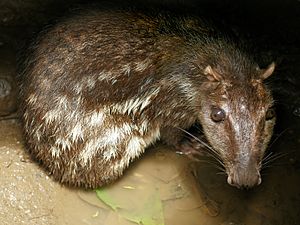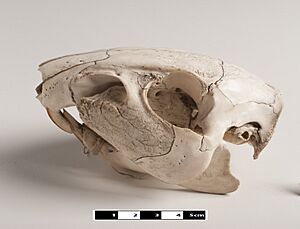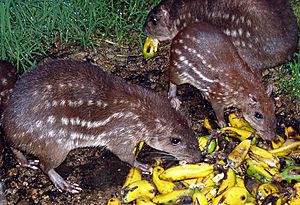Spotted paca facts for kids
Quick facts for kids Lowland paca |
|
|---|---|
 |
|
| Conservation status | |
| Scientific classification | |
 |
|
| Lowland paca range | |
| Synonyms | |
|
Mus paca Linnaeus, 1766 |
The lowland paca (Cuniculus paca) is a large rodent. It is also known as the spotted paca. You can find it in warm, wet parts of America. Its home ranges from central Mexico down to northern Argentina. This animal has also been brought to Cuba and Algeria.
People call the paca by many names. In most places, it's simply paca. In Mexico and Central America, it's often tepezcuintle. Other names include guardatinaja in Nicaragua and pisquinte in northern Costa Rica. In Belize, it's called gibnut and is a popular animal for hunting. Even though lowland pacas are not in danger of disappearing, some local groups have vanished. This is mainly because their homes are being destroyed.
Contents
What's in a Name?
The word paca comes from an old language called Tupi language. In Tupi, it means 'awake' or 'alert'. This fits the paca's nature!
The name tepezcuintle comes from the Nahuatl language. It means 'mountain-dog'. This name combines tepetl (mountain) and itzquintli (dog).
Paca's Look and Features
The lowland paca has rough fur. It does not have a soft undercoat. Its upper body is dark brown to black. Its belly is white or yellowish. It often has three to five rows of white spots along its sides. These spots stand out against a dark grey background.
Pacas have strong, thick legs. Their front feet have four toes. Their back feet have five toes, but two are very small. Their nails are strong and work like hooves. The paca's tail is short and has no hair. A special part of its skull, called the zygomatic arch, is very wide. This part helps the paca make sounds. It acts like a sound box, which is unique among mammals.
An adult lowland paca usually weighs between 6 and 12 kilograms (13 to 26 pounds).
Paca Life Cycle
Female pacas usually have one baby at a time. Sometimes they have two. They can have one to three litters each year. Pregnancy lasts about 115 to 120 days. Pacas become adults and can have babies when they are about one year old. A paca can live for up to 13 years.
Lowland pacas can carry certain diseases. These include leishmaniasis and trypanosomiasis.
Paca Habits
The lowland paca is mostly active at night. It prefers to live alone. Pacas do not make much noise. They live in forests close to water, like small rivers. They dig simple burrows about 2 meters (6 feet 7 inches) deep. These burrows usually have more than one way out. Sometimes, they use burrows made by other animals.
The lowland paca is a very good swimmer. If it senses danger, it will usually jump into the water. It can stay underwater for several minutes. Pacas are also good climbers. They climb trees to find fruits to eat.
Pacas help spread seeds in the forest. Their diet includes many things. They eat leaves, stems, roots, and nuts. They also enjoy fruits like avocados, mangos, and zapotes. They eat wild chataigne, hog plum, and guava. They also eat fruits from plants that humans have brought, like jack-fruit. Sometimes, they store food for later. Pacas have also been seen eating dead animals. This might help them get enough protein.
Paca and People
Farmers sometimes see the lowland paca as a pest. This is because pacas eat crops like yam, cassava, sugar cane, and maize. However, paca meat is highly valued by many people.
In protected areas, there are many pacas. So, they are not in danger of extinction. But overall, their numbers have gone down a lot. This is due to hunting and their homes being destroyed. Pacas can be raised on farms. However, some people say the meat from farmed pacas does not taste as good.
Many animals hunt pacas. These predators include ocelots, jaguars, coyotes, bush dogs, crocodiles, and boa constrictors.
See also
- Agouti
- Mountain paca





